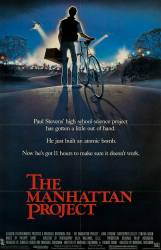Corrected entry: The kid steals a jar of 99.997% pure Plutonium, and carries it around with him. 25mm of lead shielding would have not been sufficient to prevent radiation poisoning.
Corrected entry: Paul Stevens breaks into the secret lab to steal some plutonium. After procuring a small container full of the material, he then cuts a small hole through the building's wall with a huge laser. He straps the plutonium to a radio controlled toy car and puts it through the hole. After getting himself out of the building by another route, he then drives the toy car through a drain pipe to re-acquire it. But why go to all that trouble with the laser, etc.? He had to walk out of the lab somehow. Why not just carry the plutonium out with him? The reason, of course, is that the laser looked pretty cool on screen.
Correction: There are radiation detectors at the entries and exits to keep people from stealing the plutonium. Much like metal detectors and sensitive scales at gold processing facilities.
Corrected entry: When Paul forms the plutonium into a ball, he slips it into one end of a transfer pipe, and uses a magnet on a chain to retrieve it from the other end. However, it should be noted that plutonium is NOT magnetic.
Correction: Paul didn't form the plutonium into a ball. He placed it inside a metal sphere. The sphere containing the plutonium was magnetic.
Corrected entry: Radiation does not cause electronic timers to accelerate.
Correction: Please provide some explaination for this assumption. In the movie Dr. Mathewson explains how the radiation causes the timer to accelerate, if you have evidence that this doesn't work in the real world (and specific proof that it would not occur for this particular device) please give a short synopsis in your submission.
Corrected entry: A neutron-emitting "initiator" is needed to set off a nuclear bomb, but there is use (or even mention) of such in the movie.
Correction: This was a different type of bomb that used compression through the explosives that were placed around the core like a soccer-ball.
Corrected entry: Very early in the film, the percent purity of the processed Plutonium is shown being ranked on a graph by mass in atomic mass units. Much later that same measurement is shown being graphed in terms of alpha emission energy.
Correction: That doesn't mean they weren't simply looking at different meassures at the next point in the movie.
Corrected entry: Paul Stevens finds an anomalously large number of mutant five leaf clovers on the lawn outside the secret weapons laboratory, which is presented as evidence of the large quantity of highly radioactive plutonium within. If the radiation were leaking out in large enough amounts to cause that many mutations in the plant life, then surely everyone both inside and immediately outside would be as good as dead.
Correction: The concept is supposed to be that small plant life, especially one as simple as a four-leaf clover, is far more sensitive to changes in the environment and dangerous toxins than more complex life like humans. It is this very reason that coal miners took small birds with them into the mine shafts. If they hit some dangerous gasses, the bird would die first. It is unknown if any of these people have or would eventually show signs of radiation poisoning as it is never covered in the film.
Corrected entry: In the last few minutes of the film the kid's homemade nuclear implosion bomb is stuck with the timer ticking away toward zero, at which it'll explode and destroy everything within a radius of several miles. Everyone in the lab is frantically trying to figure out how to disarm the bomb without setting it off in the process. In fact, all they have to do is find some crude way to smash the device, ruining the spherical symmetry of the jacket of conventional chemical high explosive surrounding the smaller sphere of fissile plutonium. By destroying the spherical symmetry of the implosion, the nuclear chain reaction will not proceed efficiently. Thus, even if the timer sets off the device, only the comparatively harmless chemical explosive will detonate.
Correction: The "comparatively harmless chemical explosive" would, at best, spread deadly plutonium around (plutonium is highly toxic even without its radioactivity). It would be just like the "Dirty Bombs" anti-terrorism experts are so concerned about, and might cause as much damage to life and property as a nuclear explosion (albeit in a different way). They would try every other option to defuse the bomb, before they did something as dangerous and irresponsible as destroying it.






Correction: This isn't true. While a fissile material, a sub-critical mass is relatively safe to handle with gloves and preventing if from being exposed to air.